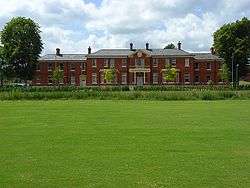Tidworth Camp
Tidworth Camp is a military installation at Tidworth in Wiltshire, England.
| Tidworth Camp | |
|---|---|
| Tidworth | |
 Lucknow Barracks | |
 Tidworth Camp Location within Wiltshire | |
| Coordinates | 51.23217°N 1.67451°W |
| Type | Barracks |
| Site information | |
| Owner | Ministry of Defence |
| Operator | |
| Site history | |
| Built | 1897 |
| Built for | War Office |
| In use | 1897–present |
| Garrison information | |
| Occupants | Various |
History
The Camp was established when the War Office acquired a 19th-century mansion – Tedworth House – and large tracts of land to its north in 1897.[1] Headquarters Southern Command was established at Tidworth Camp in 1905.[2]
Lucknow Barracks and Mooltan Barracks were completed in 1905, Tidworth Military Hospital was finished in 1907. Aliwal Barracks, Assaye Barracks, Bhurtpore Barracks, Candahar Barracks, Delhi Barracks and Jellalabad Barracks were added later,[3] and a Royal Ordnance depot was established during the First World War. The barracks are named for battles in India and Afghanistan: Aliwal, Assaye, Bhurtpore, Candahar, Delhi, Jellalabad, Lucknow and Mooltan.[4]
There was also an army hospital during the First World War. A description of it, including actions taken to address a suspected meningitis outbreak, is provided by Arthur Bullock, who spent around a week there in 1918.[5]
In the Second World War, the Camp was home in 1944 to formations of the United States Army: first the 9th Armored Division,[6] and later the 8th Armored Division.[7] HQ Southern Command left the Camp and moved to Erskine Barracks near Fugglestone St Peter in 1949.[8] The military hospital closed in March 1977.[9]
Extensive reconstruction at the Camp involving 160 new or refurbished buildings was carried out under Project Allenby Connaught between 2006 and 2014.[3]
Tedworth House had various military uses, including providing accommodation for nurses; from 1977 to 2011 it was the Officers' Mess for the Camp.[10] It is now a recovery centre operated by the Help for Heroes charity.[11]
Military cemetery
Tidworth Military Cemetery, north of the Camp and surrounded by farmland, is under the care of the Commonwealth War Graves Commission. 417 First World War burials from Tidworth, and from Fargo Military Hospital near Larkhill, include many of Australian or New Zealand servicemen. There are also 106 graves of the Second World War and 40 of other nationalities.[12]
Former branch railway
A branch from the Midland and South Western Junction Railway at Ludgershall was built in 1901 and opened to passengers in 1902.[13] Goods tracks known as Tidworth Military Railway continued west from Tidworth station into the military area. The branch returned to military control in 1955 and was closed in 1963.[14][15]
Current occupants
As of May 2020, units at Tidworth Camp include:
- HQ 1st Armoured Infantry Brigade – Delhi Barracks[16]
- 1st Armoured Medical Regiment – Bhurtpore Barracks[17]
- HQ 1 Artillery Brigade and Headquarters South West – Jellalabad Barracks[18][19][20]
- King's Royal Hussars – Aliwal Barracks[21]
- 5 Force Support Battalion REME, part of 104th Logistic Support Brigade[22]
- 6 Armoured Close Support Battalion REME – Delhi Barracks[23]
- Royal Regiment of Fusiliers, 1st Battalion[24]
- Royal Tank Regiment – Aliwal Barracks[25]
References
- Page, William, ed. (1911). "Victoria County History: Hampshire: Vol 4 pp391-394 – Parishes: Tidworth, South". British History Online. University of London. Retrieved 30 May 2020.
- "General Sir Ian Hamilton". Liddell Hart Centre for Military Archives. Retrieved 22 November 2014.
- "Tidworth Overview". Aspire Defence. Archived from the original on 26 March 2014.
- "Mooltan Barracks, Tidworth". British listed buildings. Retrieved 6 March 2017.
- Bullock, Arthur (2009). Gloucestershire Between the Wars: A Memoir. The History Press. p. 54. ISBN 978-0-7524-4793-3.
- Ken Wakefield (24 March 2014). The Other Ninth Air Force: Ninth US Army Light Aircraft Operations in Europe 1944-45. Fonthill Media. GGKEY:6KCZWNPHUL0.
- Charles R. Leach (1992). In tornado's wake: a history of the 8th Armored Division. Battery Press. p. 47.
- "'Fugglestone St Peter', in A History of the County of Wiltshire: Volume 6". 1962. pp. 37–50. Retrieved 22 November 2014.
- "Tidworth Military Hospital". Retrieved 22 November 2014.
- "Last lunch at Tedworth House". Salisbury Journal. 3 February 2011. Retrieved 22 November 2014.
- "Recovery in the South | Tedworth House". Help For Heroes. Retrieved 27 May 2020.
- "Tidworth Military Cemetery". Commonwealth War Graves Commission. Retrieved 2 December 2014.
- Historic England. "Tidworth Military Railway (1359011)". PastScape. Retrieved 1 March 2015.
- Steph Gillett (15 August 2018). The Midland & South Western Junction Railway Through Time. Amberley Publishing. ISBN 978-1-4456-6337-1.
- Oakley, Mike (2004). Wiltshire Railway Stations. Wimbourne: The Dovecote Press. pp. 133–134. ISBN 1-904349-33-1.
- "1 Armoured Infantry Brigade". www.army.mod.uk. Retrieved 26 May 2020.
- "1 Armoured Medical Regiment". www.army.mod.uk. Retrieved 26 May 2020.
- "Historic event takes place in Tidworth Camp". British Army. 10 December 2014. Archived from the original on 23 September 2015. Retrieved 13 August 2015.
- "Tidworth Camp". Warfare Today. Retrieved 12 October 2019.
- "3rd (United Kingdom) Division". www.army.mod.uk. Retrieved 26 May 2020.
- "King's Royal Hussars". www.army.mod.uk. Retrieved 26 May 2020.
- "104th Logistic Support Brigade". www.army.mod.uk. Retrieved 26 May 2020.
- "6 Armoured Close Support Battalion". www.army.mod.uk. Retrieved 26 May 2020.
- "Royal Regiment of Fusiliers". www.army.mod.uk. Retrieved 26 May 2020.
- "Royal Tank Regiment". www.army.mod.uk. Retrieved 26 May 2020.